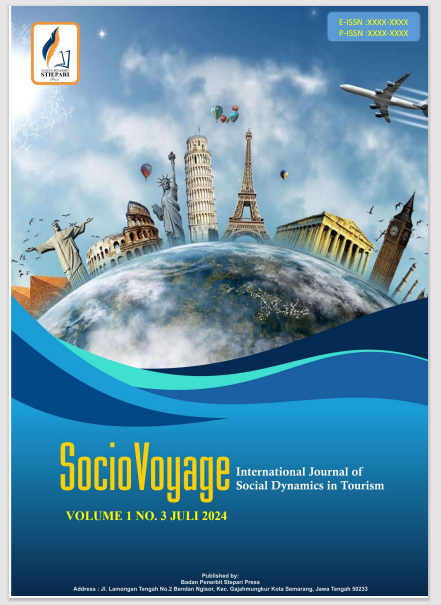Development of Disabled-Friendly Tourism Infrastructure: Providing Accessibility for All Tourists
DOI:
https://doi.org/10.56910/sociovoyage.v1i3.4Keywords:
Accessible tourism, Disability-friendly infrastructure, Tourism developmentAbstract
This research aims to assess the level of accessibility of tourism infrastructure for people with disabilities and analyze the challenges faced in its development. Qualitative research method was employed with descriptive analysis of data from sources such as the Central Statistics Agency (BPS), World Tourism Organization (UNWTO), and previous studies. The findings indicate that tourism infrastructure is still far from adequate in meeting the needs of tourists with disabilities. Lack of regulations, budget constraints, and insufficient staff training are the primary challenges. As a solution, the Development Model of Disability-Friendly Tourism Infrastructure is recommended, including physical design considerations for accessibility, staff training, and provision of easily accessible information. Collaboration among government, tourism industry, and civil society is crucial in creating a more inclusive tourism environment.
References
Amnesty, SKW (2021). Implementation of fulfilling the rights of persons with disabilities towards a disabled-friendly Purworejo. Borobudur Law Review , 3 (1), 54–72. https://doi.org/10.31603/burrev.5449
Dacholfany, MI, Rahmi, H., & Tira, DS (2023). EVALUATION OF THE DISABILITY-FRIENDLY EDUCATION MANAGEMENT MODEL IN ELEMENTARY SCHOOLS. Journal of Educational and Psychological Studies , 1 (2), 92–101. https://doi.org/10.61397/jkpp.v1i2.54
Dhairyya, AP, & Herawati, E. (2019). Social and Economic Empowerment of Groups of People with Physical Disabilities in Bandung City. Umbara , 4 (1), 53. https://doi.org/10.24198/umbara.v4i1.19039
Ebenhaezer Alsih Taruk Allo. (2022). PERSONS WITH DISABILITIES IN INDONESIA. NUSANTARA: Journal of Social Sciences , 9 (3).
Elyezer Yulius Rinekso. (2020). Fulfillment of the Rights of Persons with Disabilities at Tourist Attractions (Descriptive Study Regarding the Availability of Facilities for Persons with Disabilities in Taman Bungkul Surabaya). Diss. Airlangga University .
Isnaini, H., Permana, I., & Lestari, RD (2022). Mite Sanghyang Kenit: Natural Tourism Attraction in Rajamandala Kulon Village, West Bandung Regency. TOBA: Journal of Tourism, Hospitality, and Destination , Volume 1, Number 2 , 64-68.
Mahdy, MR, Fuady, Z., & Rizkiya, P. (2024). Accessibility of Persons with Disabilities to Tourist Areas in Bukittinggi City, West Sumatra. Scientific Journal of Architecture and Planning Students , 8 (1), 121–131. https://doi.org/10.24815/jimap.v8i1.26692
Muhammad Hasanuddin. (2019). Analysis of Tourism Facilities at the Batu City Transportation Museum for Visitors with Disabilities. Diss. Brawijaya University .
Rahmawati, R., & Putranto, HA (2023). DISABLED-FRIENDLY PUBLIC SERVICE MODEL INITIATIVE TO BUILD INCLUSION CITIES. Public Enlightenment , 10 (1), 37–55. https://doi.org/10.33084/pencerah.v10i1.4964
Shaleh, I. (2018). Implementation of Fulfillment of Employment Rights for Persons with Disabilities in Semarang. Kanun Journal of Legal Studies , 20 (1), 63–82. https://doi.org/10.24815/kanun.v20i1.9829
Sholihah, I. (2016). NEW POLICY: GUARANTEE OF FULFILLMENT OF RIGHTS FOR PERSONS WITH DISABILITIES. Socio Informa , 2 (2). https://doi.org/10.33007/inf.v2i2.256
Suhendra, A. (2017). Strategy of the Banda Aceh City and Surakarta City Governments in Realizing Disability Friendly Cities. Reform Dimensions , 1 (3), 131–142. https://doi.org/10.21787/mp.1.3.2017.131-142
Zakiyah, U., & Husein, R. (2016). TOURISM IS FRIENDLY FOR PEOPLE WITH DISABILITIES. Journal of Governance and Public Policy , 3 (3), 482–505. https://doi.org/10.18196/jgpp.2016.0068







